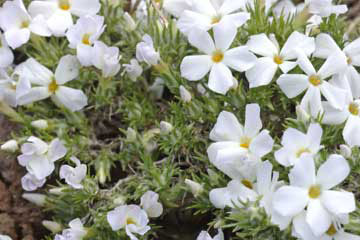 |
Spreading phlox, Phlox diffusa
Benth. var. longistylis (Wherry) M. E. Peck (left).
"Phlox" (ancient Greek for “flame”) was the name of a now unknown
plant, and later given to our plants. Phlox diffusa, is common in
our mountains, growing in clumps of narrow gray-green leaves surmounted by
a profusion of white (usually), pink, or lavender flowers. Spreading phlox
dots rocky slopes from early April at mid-elevations, well into the summer
at timberline and higher. A rather similar species, Phlox hoodii
Richardson, is common at lower altitudes.
Longleaf phlox, Phlox
longifolia
Nutt. (right). The longleaf phlox grows at all elevations,
blooming from late in the spring well into the summer; depending on the altitude.
The plant is taller, has narrower petals, longer leaves and less tightly
clustered flowers than those of the spreading phlox. Nathaniel Wyeth (he
of the wyethias) collected the original specimen in 1833 in Idaho or Montana,
and his friend Thomas Nuttall described the species the following year.
|
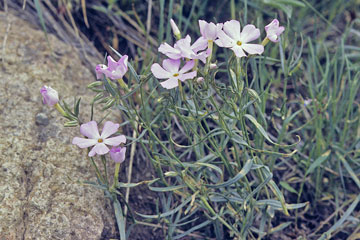 |
 |
Showy phlox, Phlox
speciosa
Pursh (left). The showy (speciosa) phlox grows
at lower elevations than do those shown above, often growing with sagebrush
in the foothills and lower mountains. It is more common in the northern half
of Idaho. Lewis and Clark collected the plant on May 7, 1806, while in what
today is Nez Perce County on their return journey. This is the only phlox
in our area with prominently notched petals. The showy phlox makes a good
garden ornamental.
Slender phlox, Microsteris gracilis
(Hook.) Greene var. humilior (Hook.) Cronquist
(right). The slender phlox (also classified as Phlox
gracilis) appears in the spring, sometimes in large numbers. Its flowers
may be pink or white. They are borne in pairs, although they do not always
bloom at the same time. Typically the petals are notched at the end. Elliptical,
opposed leaves become narrower and more pointed toward the top of the stem.
The plant is only about two inches high, so single plants are easily missed.
Its varietal name humilior means “low-growing” or
“dwarf.” Microsteris was derived from the Greek
mikros (small) and sterizo (to support, or prop up) evidently
having to do with the plant’s small size. |
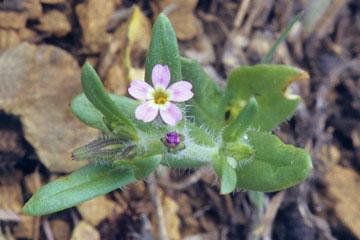 |
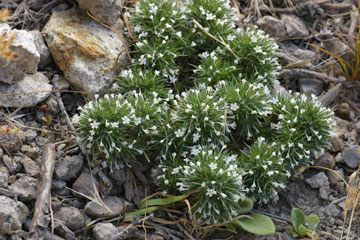 |
Mountain navarettia, Navarretia
divaricata (Torr.) Greene
(left) grows fairly high in the mountains. This small, cactus-like plant's
generic name, divaricatum, means branching, chosen because, uniquely,
branches are given off from within the terminal leaf clusters. The plants
grow in recently moist place, and with dry weather they become brown, prickly,
powder-puff-sized ghosts of their former selves.
Brewer’s navarretia, Navarretia
breweri (A. Gray) Greene
(right). Brewer’s navarretia’s yellow flowers
measure no more than 1/8 inch across. Typically, several flowers grow at
the end of the stems, surrounded by needle-shaped leaves (navarretias are
also known as “pin-cushion plants”). The genus was named for Francisco
Fernandez Navarrete (d. 1689), a Spanish missionary, physician, and botanist.
William Henry Brewer (1828-1910) was an associate of mineralogist Josiah
Dwight Whitney (of Mt. Whitney) while surveying California (1860-1864) and
later professor of agriculture at Yale. |
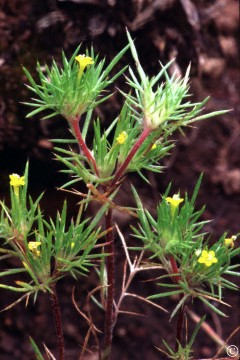 |
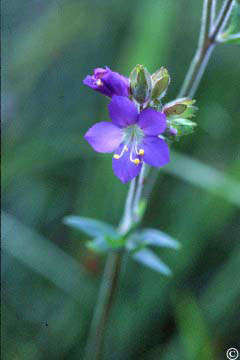 |
Western Jacob’s-ladder, Polemonium
occidentale Greene
(left) is a moist-meadow and streamside plant a
foot or more high that grows as high as the subalpine zone. It is closely
related to an uncommon European alpine, Polemonium caeruleum and some
botanists believe that ours is a variety of that plant. Furry stems are topped
with small, five-petaled bright blue flowers. Prominent yellow anthers on
long filaments add to the flower’s attractive appearance. The name
Jacob’s-ladder reflects the plant’s feathery compound leaves, common
to the genus. These give off a pronounced skunk-like odor when crushed; the
smell may be the first indication that polemoniums are growing nearby
Showy polemonium, Polemonium
pulcherrimum Hook.
(right). Lewis and Clark collected a species of polemonium
on the Lolo trail on June 27, 1806 believed originally to be
Polemonium occidentale. It seems more likely, however, that it was
the showy polemonium, a common species along their trail on that date. While
the plant shown here—photographed on a shady slope near Lolo Pass—has
pale blue flowers, those growing in the open are often bright blue. The name,
pulcherrimum, means “most beautiful.” |
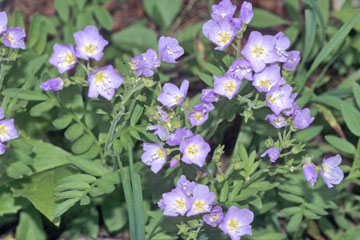 |
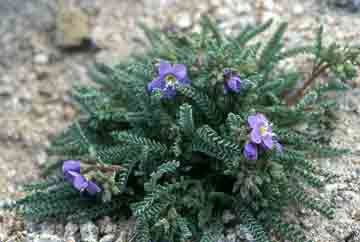 |
Sticky (also skunk) polemonium, Polemonium
viscosum Nutt.
(left). The sticky polemonium (or Jacob’s ladder) is an
attractive, low-growing plant with deep blue flowers and pinnate leaves populated
with small, tightly ranked leaflets. When crushed, this plant’s leaves
give off a strong skunk-like odor—“skunk polemonium” is another
common name. The plants grow in separate clumps and are found quite high;
we have seen small specimens growing well above treeline.
Nuttall’s leptosiphon, Leptosiphon
nuttallii (A. Gray) J. M. Porter & L. A.
Johnson (right). This attractive plant (originally classified
as Linanthastrum and more recently as Linanthus) is a common,
summer- blooming wildflower that grows as high as tree-line. Typically,
it forms discrete clumps. Its linear, alternate leaves are so close together
that they appear to form separate rosettes on the plants’ woody
stems. White, yellow-eyed flowers are five-petaled; each has five prominent
anthers. Thomas Nuttall found the species, then new to science, near Fort
Hall in 1834. The name Leptosiphon is a recently restored prior
classification derived from the Greek; it means “slender tube”
for the narrow flower tube.
|
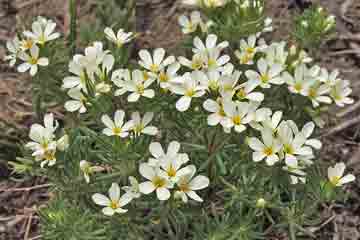 |
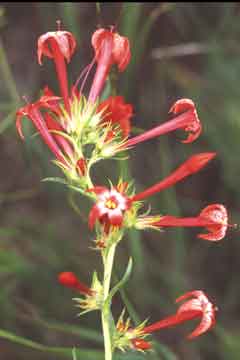 |
Scarlet gilia, Ipomopsis
aggregata (Pursh) V. Grant
(left) The scarlet gilia (formerly Gilia aggregata)
blooms in late spring, peaks in early summer, and lingers on into late summer.
One cannot hike our trails without encountering its trumpet-shaped, bright
red flowers. The flowers and foliage have an acrid odor when crushed, so
“skunk-flower” is another name for the plant, although the odor
really is not skunk-like. The name Gilia honors Italian naturalist and clergyman,
Filippo Luigi Gil (1756-1821), Director of the Vatican observatory. The species
name “aggregata” refers to the loose flower clusters. The
present generic name, Ipomopsis means “morning glory-like.”
Lewis and Clark collected the scarlet gilia—a plant hitherto unknown
to science—while on the Lolo trail in north-central Idaho during their
return trip (June 26, 1806).
Ball-head gilia, Ipomopsis
congesta, (Hook.) V. Grant var. viridis
(Cronquist) Reveal (right) Here is another gilia
that has been reclassified as an Ipomopsis. The species name,
congesta, reflects the plant’s round flower head, with its many
tiny phlox-like flowers. It grows high in the mountains on dry sandy slopes,
blooming in mid-summer. The leaves are silvery-green, usually with three
linear leaflets, arising from a central branched woody stem. Nine varieties
of this plant are recognized, classified mostly by the shape of the leaves.
|
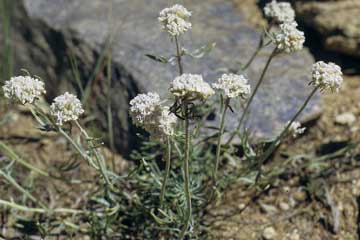 |
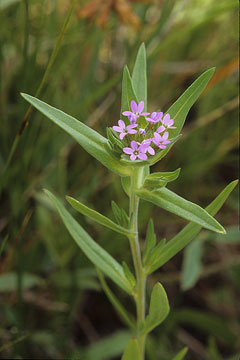 |
Narrow-leaf collomia, Collomia
linearis Nutt. (left). The
narrow-leaf collomia's five-petaled flowers are about a quarter of an inch
in diameter, with a long flower tube. The name linearis describes
the plant’s narrow leaves; Collomia, from the Greek, means
“glue,” because the seeds become mucilaginous when wet—a property
that helps to identify plants in this family. This plant is so common in
early spring that anyone hiking in our mountains will see it. Lewis and Clark
were first to collect this plant (April 17th, 1806) at today’s The Dalles,
Oregon, on their homeward journey. Frederick Pursh, who described the
expedition’s plants, did not recognize their specimen as a new species
and it remained for Thomas Nuttall to find it again.
Diffuse mountain-trumpet, Collomia tenella
Gray (right). This collomia is blooms in late spring.
Its white flowers are notable for their peculiar involucrum with its black
markings and small "horned" projections (inset). The plant is covered with
small hairs, best seen with magnification. Many of the hairs end in small
pigmented glands that may cause all or part of the plant to appear black.
This collomia grows in Idaho and surrounding states (excepting
Montana). |
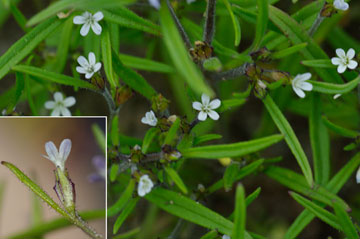 |













